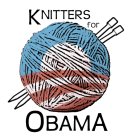Another year, another Lambtown :) Just like last year, my experience this year was quite different from the last and also quite wonderful. I went more to be able to take my son and gander at fiber animals and the fair atmosphere than to purchase fiber and (...) -- mission accomplished.
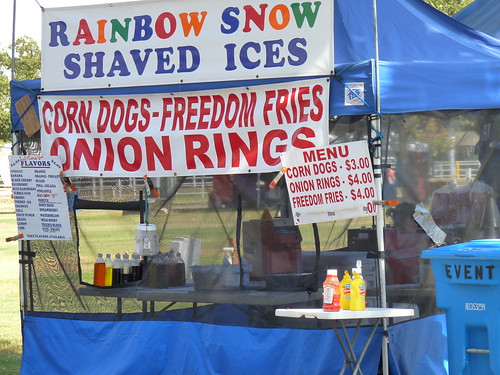
still with the freedom bit?
Tika was able to join up with us and this may have been the best part of my kid's day :)
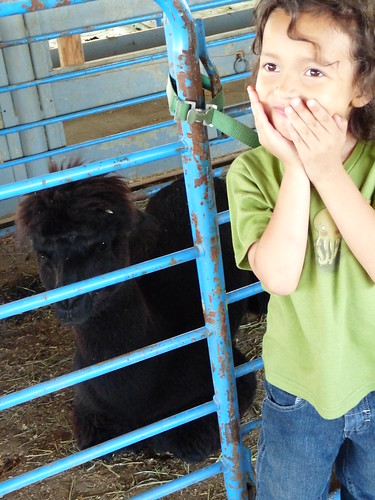
(my son LOVES her, can you tell?)
Well, minus the bouncy house and train ride... so number 3. Pretty high for a 5 year old surrounded by animals and food :) They had a lot of kid-friendly activities I never paid attention to before, including the sheepdog trials and pony rides (we missed both, but don't tell the kid, I think he's forgotten by now.) Lambtown was also moved from July to October, and it was SO MUCH NICER weatherwise than the past two years. More coordinated overall as well-- very nice to see our local fiber expo growing.
Lambtown had a large alpaca contingent this year with Calpaca running concurrently which was fun to see, including an alpaca fleece judging which I didn't watch. I did get to watch the fleece judging (of course!)... this year's judge was Martin Dally.

I have to say, he was the best judge I've had the pleasure to watch so far. It's not that the others were bad-- it's more that Martin is almost a showman in offering information about judging and buying fleece. I was also super impressed that he was the judge for the open and fiber sheep show (also missed). I took a few notes and am going to add them to the end of the post-- feel free to skip them, but I don't want to forget so it seems like a good place to store them :)
The judging this year was split into three divisions: 1) colored handspinner's wool, 2) handspinner's white wool, and 3) market (white) wool. The field was definitely smaller than Monterey's, and did not include breed classes. It makes sense for Monterey to have so many categories since they have so many to judge/for sale and want to accommodate as many as possible. Then again, the breed class judging is almost a... disservice to handspinners (reluctant to use that word) because of the issues Heather and I saw with it at the Monterey judging in 2009-- the fleeces in the breed classes aren't judged on external problems with the fleece (second cuts, VM) as it isn't not a fault in the breed standard but a bugger for handspinners buying fleeces.
The question of "handspinner's" wool came up during the judging-- to the eye, many handspinners and market wool fleeces can't be told apart. For example, the stunner I purchased...

cormo from cormo sheep and wool farm, market wool, fine 64s or finer (17-22 microns)
...doesn't really scream "market"/commercial wool, eh? More like a sheep that has never missed a meal and has a name, unlike others with numbers and that forage for food? (A distinction between the traditional market wool and handspinner's wool category, according to Dally.) I spoke to a shepherd who said that if it were done correctly, she'd only enter one fleece in the whole show since she only raises fine combing, coated handspinner's fleeces. As it is though, shepherds can choose to enter 2 fleeces into each class of each division (and rams aren't allowed in the market wool category).
Traditionally the market wool category was shaped around what commercial buyers of wool wanted-- big, productive, sound fleeces, not necessarily the showstoppers in the handspinner's class. We heard from another observer of the judging that fifty years ago shepherds used to select for heavy lanolin producing sheep to get the weight and placing up in the market wool category. This was the first time I saw an honest application of the category-- even though my "market wool" was silky and bright white, at only 5# it couldn't compare to the first place finisher at 8# that was less white and had a slightly shorter staple.

It has always felt a little sketchy to me seeing true handspinner's fleeces entered into the market wool category, even though the buyers at Lambtown and Monterey aren't industry but individual handspinners. It was good to see Dally making the distinction, and the winners of each division made sense from that standpoint.
You can see the differences here:
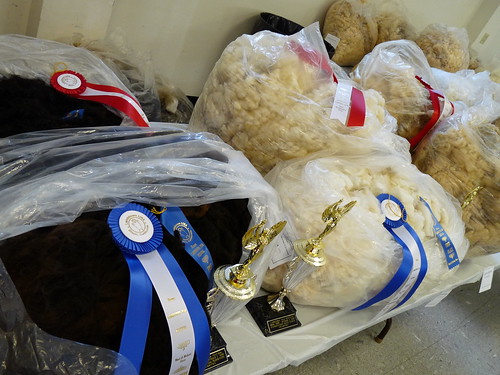
l to r: colored handspinner's fleece, handspinner's white fleece, and market wool white (champion in front, res ch in back for each)
The handspinner's category were showy but not necessarily large, and definitely well skirted. The market wool winners were definitely larger, and were discounted less heavily in judging for less dramatic skirting (though the winners were both well skirted). And the colored wool was just gorgeous as always :)
After the judging Tika, the kid and I went to see the sheep shearing competition...

...admittedly, we cringed watching blood be drawn several times. It would be interesting to see shearers work on handspinner's fleeces-- the shearing competition only judged on speed, not keeping them intact. I know Sue Reuser has invited people to come to the shearing at her farm at the beginning of the new year... it'll be an interesting trip.
Also interesting? Angora bunny shearing.
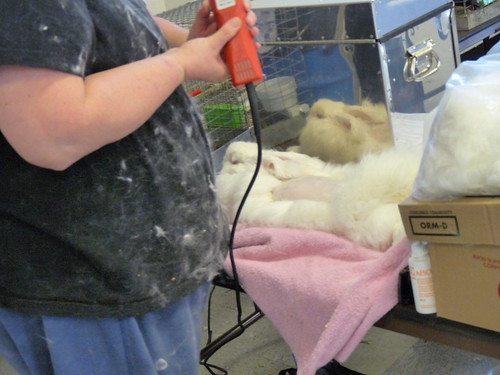
Much sweeter and with no complaints like the sheep. If only I were so easy :)
Til then!
***
Notes from Lambtown fleece judging, Martin Dally
- Wool over 30 microns will feel prickly to the skin because at that diameter, the individual fibers don't bend.
- Pick up a bag of fleece and drop it on the table. A "thump" means a less productive fleece that has a lot of dirt and VM. The dirt will add weight to the bag and make it fall louder and harder.
- Denser fleece will "hold" dirt and VM at the tip. Less dense wool will show dirt and VM further down the staple. Less dense, uncoated wool will be less productive as it will let in and hold more dirt/VM throughout the staples.
- Touch two different fleeces with two hands. If you can feel a softness difference between the two, that means there is at least a 3 micron difference between the two.
- Yellowish looking white fleece can sometimes be attributed to carotene in corn feed and soybeans; the yellow color comes out in the lanolin which coats the wool (and can be washed out). Not the only source of yellow, but a washable, non-staining one.
- The Japanese love the look of crimp in wool (hahahaha it's genetic!), Australians less so. The Japanese are also the buyers of the very finest wool produced-- they use it in undergarments.
- Fine wool fleeces that have a "shine" to them aren't "lustrous" (used exclusively for longwools), but are said to be "silky."
- A problem in uncoated fleeces is that the lanolin cannot travel to the very tips of the locks (coated in dirt/vm), and those tips will be less soft than the rest of the staple because it lacks the lanolin protection from the elements, resulting in uneven hand or broken tips in worst cases.
- A ram will produce a 10% heavier fleece than a wether as testosterone affects wool production and rams are generally larger bodied than castrated males.
- and more but my handwriting's terrible! :) next year...
(eta 10/6, found more notes...)
- Color banding within a staple (color changes that are easily delineated straight across a lock of wool) is generally a mineral issue, namely copper. Either the sheep was gestating or lactating and the amount of copper intake changes due to stresses of motherhood on the wool, or the copper supplements in the feed changed. Does not always indicate unsound wool.
- The term for uneven fleece growth in general is "cauliflowering" and should be selected against when breeding. [The term "quilting" is used for Jacob sheep as the black and white sections of wool may grow at different rates and different micron counts. --a.]
- "Crossfibering" is the term when a individual fibers cross when growing in locks. More of an aesthetic issue but non-crossed locks will show better and place better in larger competitions.
- 7 pounds of pressure is what is needed when "pinging" a lock of wool to determine soundness. If it can withstand 7 pounds of pressure then it is strong enough to withstand milling processes and spinning. Pinging any lock of wool too hard will rip it, even though it may be sound.

still with the freedom bit?
Tika was able to join up with us and this may have been the best part of my kid's day :)

(my son LOVES her, can you tell?)
Well, minus the bouncy house and train ride... so number 3. Pretty high for a 5 year old surrounded by animals and food :) They had a lot of kid-friendly activities I never paid attention to before, including the sheepdog trials and pony rides (we missed both, but don't tell the kid, I think he's forgotten by now.) Lambtown was also moved from July to October, and it was SO MUCH NICER weatherwise than the past two years. More coordinated overall as well-- very nice to see our local fiber expo growing.
Lambtown had a large alpaca contingent this year with Calpaca running concurrently which was fun to see, including an alpaca fleece judging which I didn't watch. I did get to watch the fleece judging (of course!)... this year's judge was Martin Dally.

I have to say, he was the best judge I've had the pleasure to watch so far. It's not that the others were bad-- it's more that Martin is almost a showman in offering information about judging and buying fleece. I was also super impressed that he was the judge for the open and fiber sheep show (also missed). I took a few notes and am going to add them to the end of the post-- feel free to skip them, but I don't want to forget so it seems like a good place to store them :)
The judging this year was split into three divisions: 1) colored handspinner's wool, 2) handspinner's white wool, and 3) market (white) wool. The field was definitely smaller than Monterey's, and did not include breed classes. It makes sense for Monterey to have so many categories since they have so many to judge/for sale and want to accommodate as many as possible. Then again, the breed class judging is almost a... disservice to handspinners (reluctant to use that word) because of the issues Heather and I saw with it at the Monterey judging in 2009-- the fleeces in the breed classes aren't judged on external problems with the fleece (second cuts, VM) as it isn't not a fault in the breed standard but a bugger for handspinners buying fleeces.
The question of "handspinner's" wool came up during the judging-- to the eye, many handspinners and market wool fleeces can't be told apart. For example, the stunner I purchased...

cormo from cormo sheep and wool farm, market wool, fine 64s or finer (17-22 microns)
...doesn't really scream "market"/commercial wool, eh? More like a sheep that has never missed a meal and has a name, unlike others with numbers and that forage for food? (A distinction between the traditional market wool and handspinner's wool category, according to Dally.) I spoke to a shepherd who said that if it were done correctly, she'd only enter one fleece in the whole show since she only raises fine combing, coated handspinner's fleeces. As it is though, shepherds can choose to enter 2 fleeces into each class of each division (and rams aren't allowed in the market wool category).
Traditionally the market wool category was shaped around what commercial buyers of wool wanted-- big, productive, sound fleeces, not necessarily the showstoppers in the handspinner's class. We heard from another observer of the judging that fifty years ago shepherds used to select for heavy lanolin producing sheep to get the weight and placing up in the market wool category. This was the first time I saw an honest application of the category-- even though my "market wool" was silky and bright white, at only 5# it couldn't compare to the first place finisher at 8# that was less white and had a slightly shorter staple.

It has always felt a little sketchy to me seeing true handspinner's fleeces entered into the market wool category, even though the buyers at Lambtown and Monterey aren't industry but individual handspinners. It was good to see Dally making the distinction, and the winners of each division made sense from that standpoint.
You can see the differences here:

l to r: colored handspinner's fleece, handspinner's white fleece, and market wool white (champion in front, res ch in back for each)
The handspinner's category were showy but not necessarily large, and definitely well skirted. The market wool winners were definitely larger, and were discounted less heavily in judging for less dramatic skirting (though the winners were both well skirted). And the colored wool was just gorgeous as always :)
After the judging Tika, the kid and I went to see the sheep shearing competition...

...admittedly, we cringed watching blood be drawn several times. It would be interesting to see shearers work on handspinner's fleeces-- the shearing competition only judged on speed, not keeping them intact. I know Sue Reuser has invited people to come to the shearing at her farm at the beginning of the new year... it'll be an interesting trip.
Also interesting? Angora bunny shearing.

Much sweeter and with no complaints like the sheep. If only I were so easy :)
Til then!
***
Notes from Lambtown fleece judging, Martin Dally
- Wool over 30 microns will feel prickly to the skin because at that diameter, the individual fibers don't bend.
- Pick up a bag of fleece and drop it on the table. A "thump" means a less productive fleece that has a lot of dirt and VM. The dirt will add weight to the bag and make it fall louder and harder.
- Denser fleece will "hold" dirt and VM at the tip. Less dense wool will show dirt and VM further down the staple. Less dense, uncoated wool will be less productive as it will let in and hold more dirt/VM throughout the staples.
- Touch two different fleeces with two hands. If you can feel a softness difference between the two, that means there is at least a 3 micron difference between the two.
- Yellowish looking white fleece can sometimes be attributed to carotene in corn feed and soybeans; the yellow color comes out in the lanolin which coats the wool (and can be washed out). Not the only source of yellow, but a washable, non-staining one.
- The Japanese love the look of crimp in wool (hahahaha it's genetic!), Australians less so. The Japanese are also the buyers of the very finest wool produced-- they use it in undergarments.
- Fine wool fleeces that have a "shine" to them aren't "lustrous" (used exclusively for longwools), but are said to be "silky."
- A problem in uncoated fleeces is that the lanolin cannot travel to the very tips of the locks (coated in dirt/vm), and those tips will be less soft than the rest of the staple because it lacks the lanolin protection from the elements, resulting in uneven hand or broken tips in worst cases.
- A ram will produce a 10% heavier fleece than a wether as testosterone affects wool production and rams are generally larger bodied than castrated males.
- and more but my handwriting's terrible! :) next year...
(eta 10/6, found more notes...)
- Color banding within a staple (color changes that are easily delineated straight across a lock of wool) is generally a mineral issue, namely copper. Either the sheep was gestating or lactating and the amount of copper intake changes due to stresses of motherhood on the wool, or the copper supplements in the feed changed. Does not always indicate unsound wool.
- The term for uneven fleece growth in general is "cauliflowering" and should be selected against when breeding. [The term "quilting" is used for Jacob sheep as the black and white sections of wool may grow at different rates and different micron counts. --a.]
- "Crossfibering" is the term when a individual fibers cross when growing in locks. More of an aesthetic issue but non-crossed locks will show better and place better in larger competitions.
- 7 pounds of pressure is what is needed when "pinging" a lock of wool to determine soundness. If it can withstand 7 pounds of pressure then it is strong enough to withstand milling processes and spinning. Pinging any lock of wool too hard will rip it, even though it may be sound.



